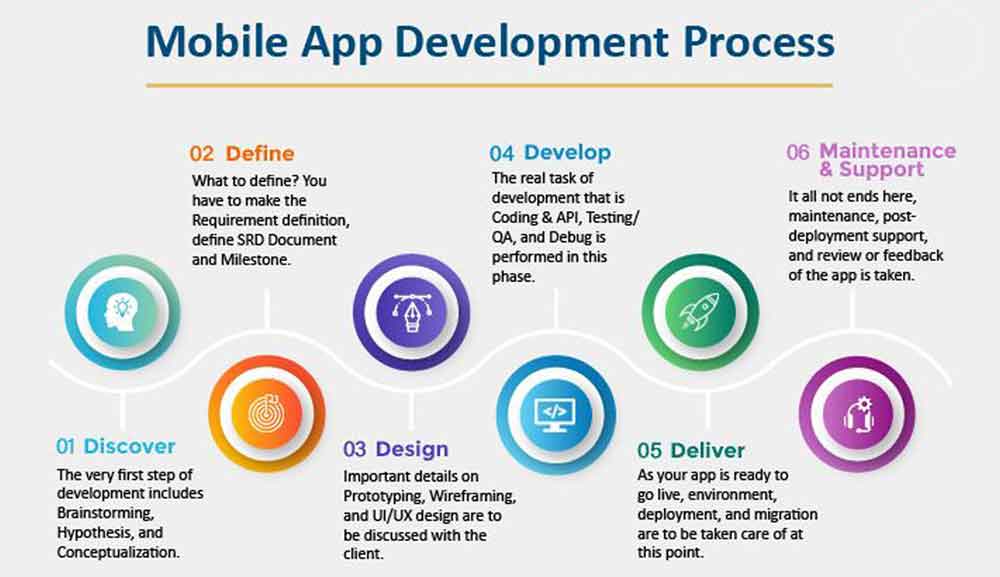The mobile app development process begins with an overall strategy. This strategy includes the business model, data requirements, user needs, and general idea behind the mobile app product. A clear understanding of what your end-users want in a mobile app is essential to creating a marketable product.
Another step is similar to the business plan stage in which you need to consider various factors before taking up a given project. These factors include market size, competition, pricing model, licensing terms for patents, etc. When you have these details fixed in your head, it is time for you to start studying all sorts of trends in the mobile apps industry. Mobile app development is a process that can be broken down into several steps. These include studying the market, designing, prototyping, coding, testing, and deploying. Knowing the cross platform mobile app development process is essential if you want to develop an app for your business or ideas. This blog has shared in-depth knowledge of all the seven fundamental mobile app development steps/processes that every startup or businesses should know while developing an app.
Step 1: Study the Market
The first step in creating a successful app is to study app statistics and usage patterns. According to the stats, mobile apps are expected to generate around $935 billion in revenue by the year 2023. A good idea would be to identify the most successful apps and figure out what makes them successful. There are around 1.96 million apps available on the App Store, and approximately 2.87 million apps available on the Play Store. This can help you understand current trends and adapt accordingly. It also gives you the latitude to adapt the app design as per your choice or must-have features that your target audience demands. Investigate all aspects of your product, such as usability, flexibility, performance, supportability, viability, and scalability, using these factors as guiding principles for making decisions throughout the development process. Understanding what your target audience wants is crucial, since it can help you stay relevant in a competitive environment.
Step 2: Define Your Business Model and End-User Experience (UX)
The business model is the foundation for any app development project. Your business model may involve any combination of tools, libraries, or plugins. So make sure to understand precisely why you want to develop an Android or iOS app in the market. Overall, there are several considerations you should make before deciding on how to make money with an app. These include the cost factor and the profit you want to make by developing and distributing an app in the market. A successful app that monetizes only through in-app purchases will have a different business model than a social networking app that generates revenue from advertisements. Once you have decided on your business model, it is vital to ensure that your mobile application meets all performance and design requirements. It may be necessary for you to test your ideas with potential users or beta testers before making any final decisions. User testing is also done during this stage to ensure that the developers meet the functional and UX requirements. A well-tested product saves development time and protects you from costly mistakes in the long run.
Step 3: Develop a Prototype
This phase focuses on the real-world look and feel of the app. It starts with creating mockups that are used for designing wireframes. After detailed sketches are created, the wireframes are converted into prototypes for user testing. Wireframes act as blueprints during this step in which you define how your app would look to the end-user. Everything from navigation buttons to content, colors, and page layouts is defined in these drawings. The process is a continuous loop between design and development teams, wherein a team passes a prototype or sketch to another team for feedback or changes based on their opinions and suggestions. It is a significant step, since it helps define the overall look and feel of your app. Make sure that the wireframes are comprehensive, and don’t leave any room for ambiguity.
Step 4: Design Your Mobile App UI/UX
In this step, you convert the newly created wireframes into a high-fidelity prototype with visual elements. You can opt for either designing your own android mobile app or hiring a professional to design an interface from which you can select those features you want to implement in the final product. Web & mobile application design has become a specialized area of expertise that needs considerable knowledge and skill. For example, outlining wireframes with Adobe Illustrator or Sketch is one of the fastest techniques to transform the app’s idea into a high-fidelity prototype.
Step 5: Build Your Mobile App Development Team
The development team for the app has to be made up of technically proficient people and have the required expertise and experience in designing, coding, and testing software applications. Communication within the team is essential throughout the mobile app development process, since it is a multitasking process that involves multiple individuals from different backgrounds. When you have a robust mobile app development team, you can easily stay updated on all new technologies and tools they use, which will help you quickly implement any updates or improvements to your apps.
Step 6: Test and Refine
The development of a mobile app can be split into two different phases: the initial development and the post-release phase. Custom mobile app development is a continuous process in which developers add new features, improve on existing versions of the mobile app, fix bugs, and test the updated versions on different platforms. By continually testing new updates and improving your app’s performance, you can increase customer retention and engagement. With every incremental update you make to your application, it is crucial to test your app and see if it stands up to expectations or not. I recommend that you create a predefined set of tests that ensure your application works as intended. During the tests, make sure to follow your mobile app development team’s code and test their work for any errors.
Step 7: Launch Your Mobile Application
After the app goes through the testing phase, it is ready to be publicly released. The release journey can be split into pre-launch testing, launch processing, post-launch testing, and rollout. With each of these phases, you can learn how your users will respond to the new version of the mobile app. The post-launch step is where you can consider launching different versions of your mobile app for different markets or geographical regions. Today, there is no shortage of tools or platforms available to help you develop, test, and launch your Android and iOS apps . There are open-source platforms like Android Studio and XCode for Android and iOS development , respectively. Google also offers the Android Studio, a cloud-based integrated development environment (IDE) for Android app development. It supports the languages Java and Kotlin, and you can use this with various services Google provides, like Firebase Test Lab to perform automated testing using real devices. Alternatively, you can also go for hybrid app development using HTML5, JavaScript, CSS3, and LESS or SaaS without downloading additional software or writing native code.
When Should You Opt for an Experienced Mobile App Development Company?
With the world moving at an unbelievable pace, your app development process must be efficient and streamlined.
The more time you spend developing your mobile applications, the better they will be. If you want to use your
time wisely without compromising on quality or user experience, you might consider hiring an experienced top
Android and iOS app development company for your business.
Using a pro allows you to leverage their extensive expertise and technical prowess to build high-quality yet
cost-effective apps. I know the process I’ve outlined works because my company uses it to design apps for a
variety of businesses. If you don’t have time to get the design right, it’s better to hire someone to work with you.
Saabsoft is a leading
mobile app development company based in Dubai, UAE.
Our team provides best-in-class development services
for iOS and Android to help you reach users on any device. We have deployed many
professional mobile apps
that have
been delivered and published to the Apple Store, Google Play, and the Microsoft Store. Our high quality, dynamic apps
are designed to be flexible and intuitive, using the latest technologies and platforms such as Xamarin, React Native,
Objective C, Swift, Flutter, Java, and more, in order to deliver a great user experience.







